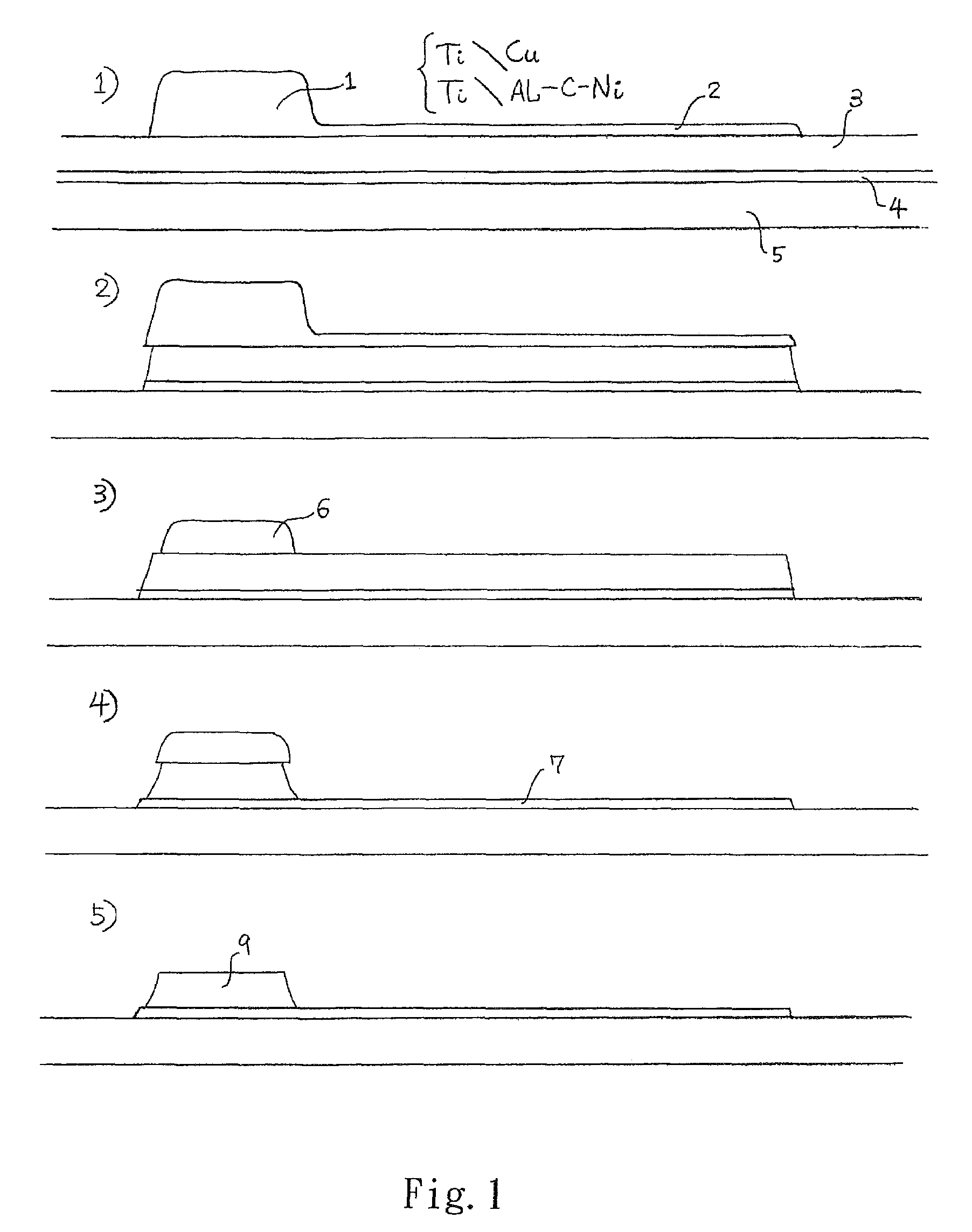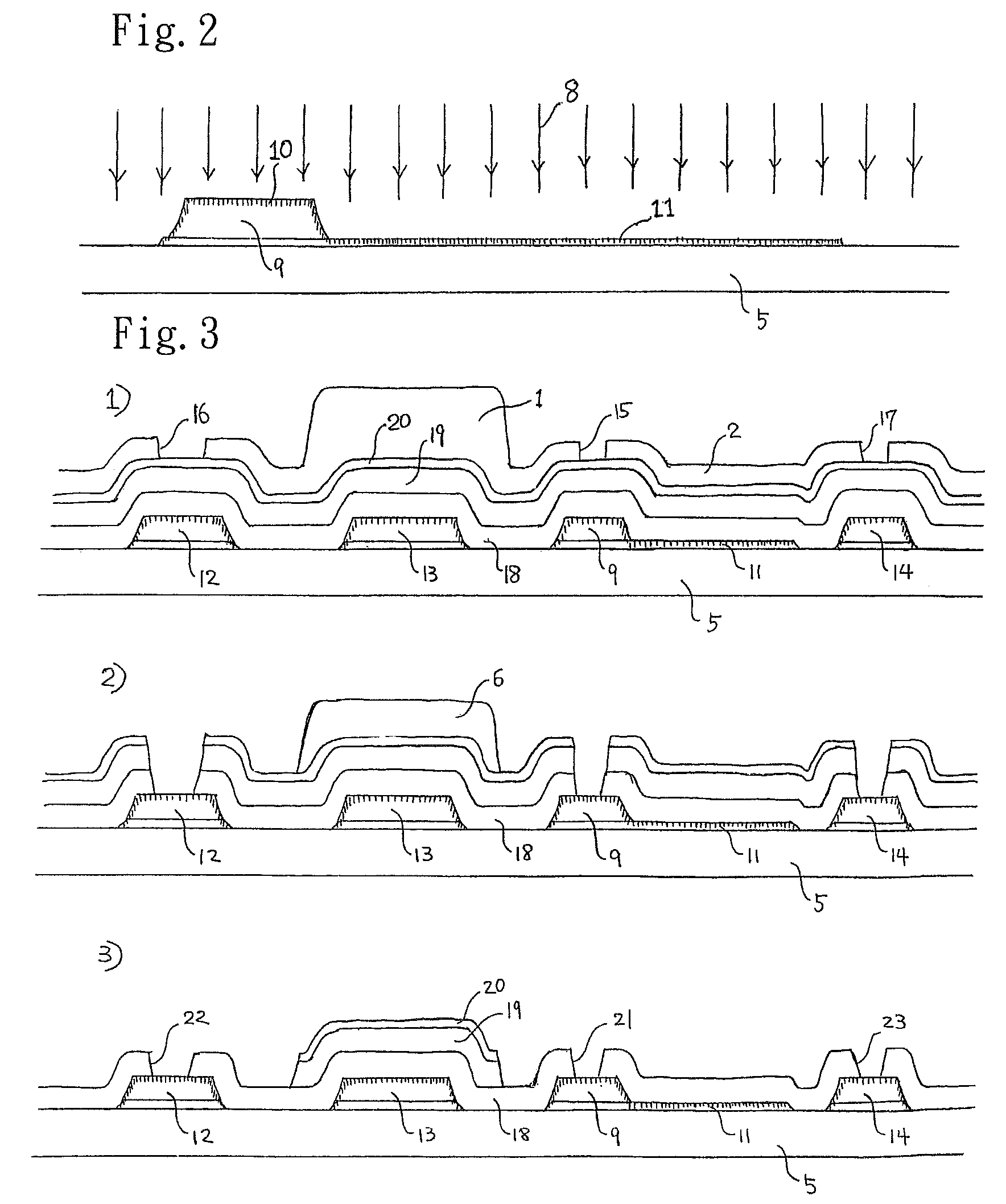Method of manufacturing LCD apparatus by using halftone exposure method
a technology of liquid crystal display and exposure method, which is applied in the direction of instruments, semiconductor devices, optics, etc., can solve the problems of abnormal etching, reduced transparent electroconductive film, and melted particles at the substrate surfa
- Summary
- Abstract
- Description
- Claims
- Application Information
AI Technical Summary
Benefits of technology
Problems solved by technology
Method used
Image
Examples
embodiment 1
[0641]Referring to FIGS. 11 to 15 for a schematic cross-sectional view of a manufacturing process of an active matrix TFT substrate in accordance with Embodiment 1 of the present invention, a titanium thin film or a zirconium thin film of 5˜25 nm is formed on a glass substrate, and then an aluminum alloy (aluminum-carbon-nickel or aluminum-neodymium-nickel), copper or copper alloy (copper-nickel or copper-chromium) or silver alloy of 200˜800 nm is formed on the whole surface of the substrate as shown in FIGS. 249 and 250. After the positive photoresist is coated, a halftone exposure method is used for carrying out an exposure to develop an image and produce a positive photoresist pattern in the shape as shown in FIG. 1-1. In FIG. 1-2, the pattern is used for simultaneously etching and manufacturing a lower layer metal thin film and an upper layer metal thin film into the same shape, and then an oxygen plasma ashing process is used for ashing away the thin positive photoresist region...
embodiment 2
[0648]FIG. 248 shows a schematic cross-sectional view of a manufacturing process for forming a pixel electrode by using the halftone exposure method in accordance with Embodiment 2 of the present invention. As shown in FIG. 1-2, two metal films are etched and manufactured to a same pattern. Embodiment 2 of the present invention is shown in FIG. 248-2. Firstly, a metal film of an upper layer is etched selectively as shown in FIG. 248-3, and after an oxygen plasma ashing process is performed to remove the region of a thin positive photoresist left from a halftone exposure, a metal pattern of the upper layer serves as a mask, and the dry etched metal thin film of the lower layer is patterned. After the upper layer metal is selectively etched and exposed, a nitrogen ion shower doping process is performed, and the nitrogen atoms doped on the metal surface of the upper layer of a contact pad portion to provide an oxidation-resisting function. In the meantime, the metal thin film pixel ele...
embodiment 3
[0650]FIG. 42 shows the cross-sectional view of a manufacturing process of forming a pixel electrode and a contact pad by using a halftone exposure method in accordance with Embodiment 3 of the present invention. This manufacturing process is classified as Type (IIa) manufacturing process as shown in FIG. 46. Aluminum alloy (aluminum-carbon-nickel or aluminum-neodymium-nickel), pure copper, copper alloy (copper-molybdenum or copper-chromium) or silver alloy (silver-copper or silver-palladium) that does not cause Hirox is used as the upper layer metal. The gate electrode and the common electrode of a super large TFT matrix substrate for LCD TV adopt the metal of the aforementioned three systems. The lower layer transparent conducting electrode of the present invention adopts titanium nitride or zirconium nitride, for the reason of: the aforementioned two types of nitride material and aluminum alloy do not cause a local cell reaction (or a Galvanic reaction). Furthermore, both wet etc...
PUM
| Property | Measurement | Unit |
|---|---|---|
| thickness | aaaaa | aaaaa |
| thickness | aaaaa | aaaaa |
| thickness | aaaaa | aaaaa |
Abstract
Description
Claims
Application Information
 Login to View More
Login to View More - R&D
- Intellectual Property
- Life Sciences
- Materials
- Tech Scout
- Unparalleled Data Quality
- Higher Quality Content
- 60% Fewer Hallucinations
Browse by: Latest US Patents, China's latest patents, Technical Efficacy Thesaurus, Application Domain, Technology Topic, Popular Technical Reports.
© 2025 PatSnap. All rights reserved.Legal|Privacy policy|Modern Slavery Act Transparency Statement|Sitemap|About US| Contact US: help@patsnap.com



